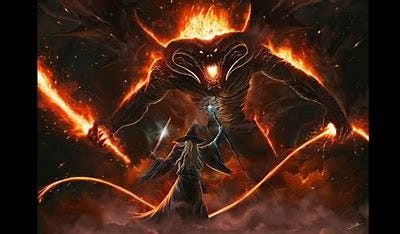Come with me to the Mines of Moria, courtesy of J.R.R. Tolkien’s The Lord of the Rings. Even if you don’t resonate with this brand of nerdom, hang around to see where we find Jesus in its midst.
In The Fellowship of the Ring, we witness a Balrog, or fire demon, in hot pursuit of the Fellowship, the group tasked with protecting Frodo on his journey to destroy the Ring. Gandalf the Gray, a powerful wizard, urges the rest of the Fellowship on through the mines while he turns back to battle the Balrog. He strikes his staff on the bridge, yells at the beast to “go back to the shadows,” and watches the bridge collapse, taking the Balrog with it. It appears the battle is over until the Balrog’s fire whip lurches back from the depths, ensnares Gandalf, and pulls him off the broken ledge. Gandalf grapples long enough to shout at the Fellowship to run, then lets go, falling into darkness with no visible end.
This is where all appears lost: Gandalf defeats the Balrog but perishes in the fight. It is not until the sequel, The Two Towers, that we are taken back into the darkness to witness what transpired.
Yes, the Balrog fell. Yes, Gandalf fell. But that was only the beginning. As they plunged through the depths of Moria, their fight continued, a battle between literal light and darkness. In a world-turned-upside-down moment, they fall out of the mine and onto a mountaintop where Gandalf deals the final blow. He later recounts, “From the lowest dungeon to the highest peak, I fought him… until at last I threw down my enemy and smote his ruin upon the mountain.”
Gandalf was victorious, and proceeds to die and come back to life. That part can be easily construed as allegory, but I want to focus on a different element: the midair, gravitational battle. I am struck by its dramatic parallels to the theological concept of the Harrowing of Hell, the time between Jesus’s death and resurrection. A time where, as the creeds and Scripture state, he “descended into hell” to preach Good News to the captives and set them free.
By entering the realm of the dead, he overwhelmed it with the “contagious holiness of God.” While examining this dark descent in his book, Lamb of the Free, Andrew Rillera quotes author Matthew Thiessen,
“What is most shocking about this portrayal is that at the very moment that the forces of impurity seem to have finally beaten Jesus, at the precise instant that Jesus becomes a corpse and presumably a source of corpse contamination, holy power emanates out of him and into the abode of death- tombs- to snatch away bodies who were themselves sources of ritual impurity. Whereas corpses usually emit some miasma of impurity, Jesus’s corpse appears to emit a miasma of holy power that selectively revivifies long-dead saints. This holy discharge is wide-ranging... reaching deep into the bowels of death to give life to those who have long been dead. [The gospel of] Matthew narrates in dramatic fashion how Jesus’s crucifixion is ultimately a victory over death itself.”
I am compelled by the likeness between the invisible nature of both Gandalf's and Jesus’ battles:
Out of sight, they enter the realm of darkness.
Out of sight, they fight for those who cannot fight for themselves.
Out of sight, they lash out at death and secure victory.
And here’s the kicker. Gandalf didn’t just fight the Balrog so the Fellowship didn’t have to. By fighting, he freed them to continue their fight to destroy the Ring in Mordor. His sacrifice enabled them to keep pushing back the darkness.
Jesus didn’t just fight death so that we wouldn’t have to. He fought and overcame to empower us to a cruciform life. Or a life patterned after the cross. He didn’t overcome death so that we wouldn’t suffer, he overcame death so that we could be given the power to make the sacrificial choices that push back darkness all around us, for the sake of the Kingdom of God. Knowing death is not the end, we can take up our cross, enter the dark places, and push them back with the True Light. Andrew Rillera writes about this extensively in Lamb of the Free and sums it up by the phrase “participatory atonement.” Essentially, Jesus went ahead of us so that we might follow in his steps. His sacrifice enables our participation in the divine life. That is exciting and terrifying.
As Lent continues, I’m keeping the image of Gandalf plunging through the mines, lashing out at the Balrog. I’m imagining Jesus in the realm of the dead, trampling on it, freeing the captives, and emerging victorious. I’m contemplating what immediate actions fit into this cross-shaped pattern of life. And here’s a prayer to close it out:
Jesus, you were not defeated by death.
Rather, you overcame it.
Smote it.
Crippled it.
Though it feebly grasps our lives,
May we recall where true power lies.
Taking up that fearsome cross,
Pushing back darkness,
knowing the cost.






“Jesus didn’t just fight death so that we wouldn’t have to. He fought and overcame to empower us to a cruciform life. Or a life patterned after the cross. He didn’t overcome death so that we wouldn’t suffer, he overcame death so that we could be given the power to make the sacrificial choices that push back darkness all around us, for the sake of the Kingdom of God.”
Yes - all of this! Thanks for writing this and then publishing it!
This is so very good Chrisann. Thank you for sharing it.